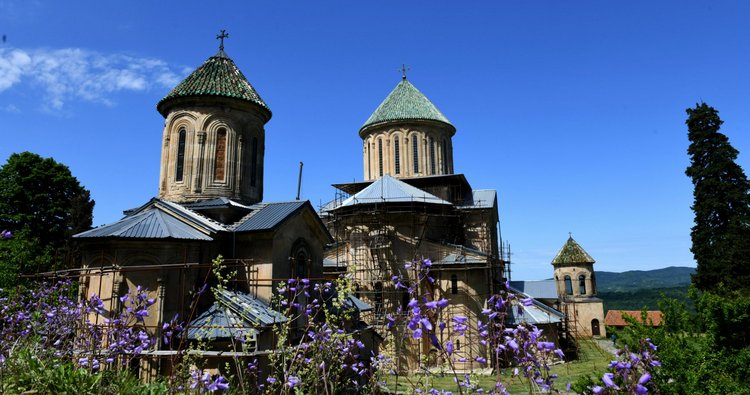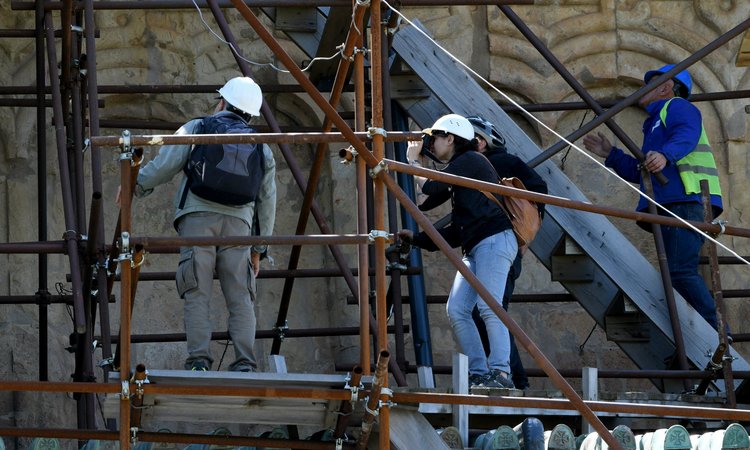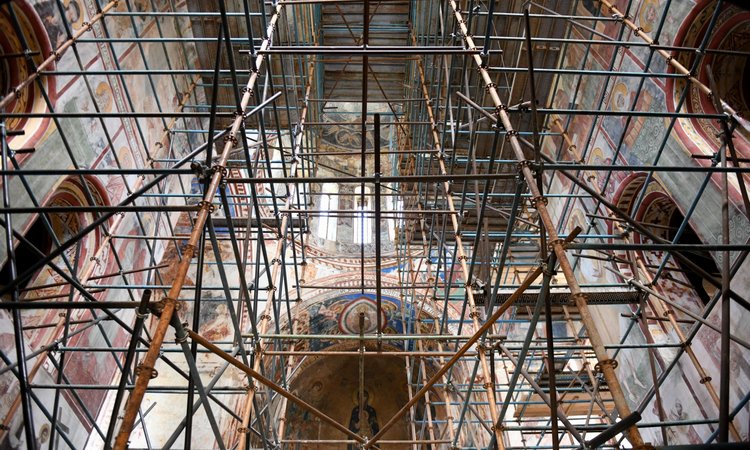UNESCO expert report on Gelati Monastery laments lack of roadmap for conservation, urges more stakeholder communication

The medieval Monastery, inscribed in the UNESCO World Heritage List in 1994, has been at the centre of a public controversy in Georgia since rainwater leakage into its structure, and subsequent damage, was revealed in recent years. Photo: Ministry of Culture, Sport and Youth of Georgia
A report involving experts from the United Nations Educational, Scientific and Cultural Organisation, the International Council on Monuments and Sites and the International Centre for the Study of the Preservation and Restoration of Cultural Property has lamented the absence of a general project for conservation works on the Gelati World Heritage Site in Georgia's west, and urged authorities to ensure more communication with local stakeholders over ongoing issues at the monument.
The report was produced following studies of the monument - which has suffered from rainwater leaks into its structure over the recent years, with professionals now scrambling to safeguard its frescoes from the ongoing damaging results of the infiltration - by an invited team involving representatives from UNESCO, ICOMOS and ICCROM, with Georgia's Ministry of Culture making the document public on Friday.
It also follows domestic controversy between the Ministry and a part of Georgia's culture sector professionals and institutions around the state of the ongoing works over the recent years, with a debate ongoing between the sides around the process that was kick-started after precipitation infiltration during the winter of 2019-2020 and the subsequent summer sparked a public outcry over the state of the monument of major national and international significance.
In the report, the team of experts have pointed to the shortcomings in the tiling of the roof of the Main Church of the monastery, installed between 2015-2018, that led to "moisture ingress and associated decay of the historic murals" inside the monument.

Georgia's Culture Ministry and the National Agency for Cultural Heritage Preservation have worked with invited foreign experts on studying the ongoing issues at the Gelati site over the recent years. Photo: Ministry of Culture, Sport and Youth of Georgia
They said in the report while moisture infiltration had been stopped by installation of temporary roofing in July 2020, the work had also precluded evaporation of the accumulated moisture through the upper parts of the roofs, with the process instead directed through the walls and "creating a critical situation for the mural paintings".
The subsequent removal of the glazed roof tiles and fill layers over the west arm, combined with a temporary raised cover, has enabled the process of progressive evaporation of the moisture towards the exterior to begin, with positive results for the wall paintings. Now there is a need to allow such process of evaporation to happen in the other arms of the church
- Report of the Joint World Heritage Centre/ICOMOS/ICCROM advisory mission
While the Georgian state bodies' "commitment of resources and expertise" for addressing the issues, and its "determination to undertake the necessary interventions" are evaluated as "highly commendable", the authors of the conclusion added the lack of detailed documentation on works at the site prior to 2020 had "made developing emergency intervention strategy more difficult".
They also pointed to the ongoing absence of an "overall project" for the conservation works that would include "various aspects related with the alteration and decay processes affecting the site". The report stressed such a written plan was "fundamental" in assessing conservation proposals and for allowing "clarity in the actions to be undertaken, facilitate communication and coordination, and ensure continuity in the actions".
The document also said while between April and August 2021 - in months immediately following the appointment of Thea Tsulukiani as Minister of Culture - the Ministry had facilitated involvement of stakeholders, such as representatives of the Georgian office of ICOMOS, in meetings for informing parties on the ongoing state of interventions and the state of conservation of the site, the practice of information-sharing had been "discontinued after summer 2021".
Overall, a more systematic and inclusive information sharing about the conservation approaches and activities at the property among different stakeholders should be encouraged. It will facilitate an effective dialogue between the State Party and the public and contribute to awareness-raising about the property and its management.
- Report of the Joint World Heritage Centre/ICOMOS/ICCROM advisory mission
The recommendations issued by the invited experts also include "immediate actions [...] on emergency stabilisation works", while the conclusions also say further conservation works should be ensured only after a "thoroughly designed and holistic conservation programme" is produced for the "entire property".
An immediate installation of an "overall protective coverage" for the monument, extension and maintenance of a "secure scaffolding in all areas of the church", and ongoing production of detailed records of works, as well as a "project and road map" for the monument, are also in the list of recommendations, along with ensuring "closer dialogue with different stakeholders" and involvement of more Georgian conservators in the efforts.

Scaffolding has been set up on both the exterior and interior of the 12th century Monastery to facilitate access to its walls for studying effects of the infiltration of precipitation. Photo: Ministry of Culture, Sport and Youth of Georgia
Both the Ministry and independent domestic culture organisations involved in discussions around the World Heritage Site reacted to the report, with the sate body pointing to the approval of its authors of the Ministry's overall efforts in addressing the issues, and highlighting the report had not called for changes to the composition of the team working on the monument.
Minister Tsulukiani also said the absence of a general project for the management of the monument was a result of the initial plans for its approval being shelved in 2017. She said a fresh look at the original project under her management at the Ministry in 2021 had discovered its "obsolescence", and added developing a new roadmap would require a "complete analysis and a new plan based on requirements".
In contrast, the National Research Centre for Georgian Art History and Heritage Preservation - the body that had criticised authorities on running the conservation works in a “centralised” and “non-transparent” manner, and said the works were being carried out through “extreme methodological violations” in a report released in late January - stressed the report by the three bodies had "essentially concurred" with its own report on subjects including "project management, decision-making process, strategic vision of the problem, setting up of temporary roofing, and methodology for the conservation of the wall murals" related to the works.
The Centre also said the Ministry had "essentially misinterpreted" the report in its comments, and added it would release its full assessment of the document at a later date.
Gelati was returned to the UNESCO List of World Heritage in 2017, after the monument had been entered in the organisation's List of World Heritage in Danger in 2010, following restoration works under the previous Government of Georgia that were initiated in defiance of UNESCO regulations and warnings on "irreversible interventions carried out on the site".
The 12th century Monastery, located 11km north-east of the western hub city of Kutaisi, was originally inscribed in the World Heritage List in 1994, with UNESCO describing it as a "masterpiece of the Golden Age of medieval Georgia".
The initial construction of the main buildings of the complex were carried out in 1106, during the reign of King David IV of Georgia. Further additions were made to the monastery between the 12th-17th centuries.
 Tweet
Tweet  Share
Share